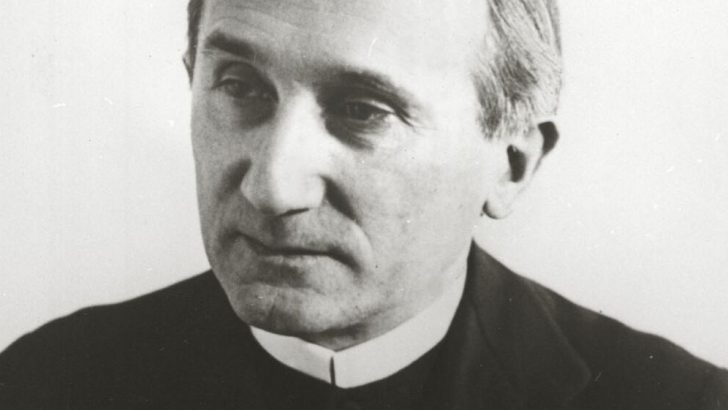Rome, in many ways, is a company town, dominated by two major industries – Italian political life and the national government, symbolised in the city’s Quirinal Palace (to Italians, simply the Quirinale), and the Papacy and the Catholic Church, iconically represented by St Peter’s Basilica.
As a result, if you’re a devotee of either industry, meaning a political junkie or a nerd for Church affairs, this town is like a never-ending Disneyland, full of rides, attractions and firework displays – there’s always another show to catch.
One of the shows this week to which I’m especially looking forward comes on Wednesday at Rome’s Opus Dei-run Santa Croce University, with a day of study devoted to Romano Guardini, one of the towering figures of 20th Century Catholic intellectual history.
It is no exaggeration to say that the Catholicism we experience today would be vastly different without Guardini’s influence, which is not just an historical artefact but very much a living force in the here-and-now.
One need look no further than Pope Francis to prove the point, since back in the 1980s the then-Fr Jorge Mario Bergoglio chose Guardini as the subject of a never-completed doctoral dissertation. The fact that Bergoglio didn’t quite complete his studies hardly means Guardini didn’t interest him, as the Italian-born German theologian and philosopher’s influence helps to shape Francis’s thought on a whole variety of fronts.
Audience
In November 2015, Francis paid tribute to Guardini during an audience for members of a German foundation devoted to his memory, who were organising a conference.
“I am convinced that Guardini is a thinker who has much to say to the men of our time, and not only to Christians,” Francis said.
Last December 16 in Munich, the city where Guardini taught for much of his career, a beatification process was officially opened at the diocesan level. Guardini died in Munich in 1968.
Auxiliary Bishop Robert Barron of Los Angeles has written masterfully on how Guardini shines through almost every page of Laudato Si’, the Pontiff’s 2015 encyclical on the environment and care of creation.
It’s a fact (I mean, it’s on Wikipedia, so it must be true) that Guardini is cited in Laudato Si’ more times than any other modern thinker who’s not a Pope – and, let’s face it, a lot of those Papal citations were pro forma, as they are in any encyclical, while the Guardini footnotes came straight from Francis’s own mind.
More than anything, Francis’s diagnosis that the post-modern human being has become progressively more alienated from nature as a result of the rise of modern science, industrial culture and contemporary capitalism – all goods in themselves, naturally, but all with shadow sides – is straight from Guardini, who saw it all taking shape in the early 20th century.
Liturgy is another arena where one can connect the dots between Guardini and this Papacy.
Granted, Francis isn’t Benedict XVI, for whom in many ways the liturgy was the touchstone of his thought on almost everything. Francis’s impatience with fussiness over the fine points of liturgical practice is legendary, and he really doesn’t talk about it all that much – except, of course, his repeated calls for better (and shorter) homilies, but that’s been such a staple of Catholic bellyaching over the years that we hardly needed a Pope to remind us of the point.
It’s also true that when Francis has to preside over a big, formal, carefully choreographed liturgy in St Peter’s Basilica, he habitually arrives early and finishes early – suggesting, at times, that he almost can’t wait for it to be over.
Ironically, probably the most consequential decision Francis has made to date on the liturgy is to voluntarily relinquish some of his own power over it, last October electing to transfer control over many matters of liturgical translation from Rome to local bishops’ conferences.
None of this, however, is to suggest that Francis doesn’t care about liturgy, because there are settings where he actually becomes quite passionate about it. One can see this especially in terms of his fondness for popular devotions, such as Marian processions, novenas, Masses for national patrons, and so on.
Outlook
That outlook, too, owes much to Guardini and his famous book The Spirit of the Liturgy, which was really the opening salvo of the modern liturgical movement. Guardini once scolded a parish priest for asking how processions could be better organised (the sort of question typical of German Catholicism, by the way), saying he’d missed the point. The real question, Guardini argued, is: “How can the act of walking become a religious act, a retinue for the Lord progressing through his land, so that an ‘epiphany’ may take place?”
In fact, Francis’s decision to empower local bishops’ conferences can be seen in this light, as opposed to being merely a hangover from Vatican II debates about whether Rome or the local churches should get to call the shots. The Pontiff realises that epiphanies come in all shapes and sizes – what it means in the Philippines during the feast of the Traslación of the Black Nazarene, for instance, is different than in Poland during pilgrimages to the Madonna of Czestochowa – and thus ‘one size fits all’ liturgical rules, in his eyes, can be problematic.
One could go on citing examples, but the point should be clear. It’s not quite as if Guardini himself were elected Pope in March 2013 – in point of fact, he once refused to even become a cardinal at the invitation of Pope Paul VI. However, Guardini’s legacy nevertheless is alive and well in the early 21st Century, including in Rome.
Pick up a volume by Guardini himself, dip in, and you’ll discover that if it’s not quite an owner’s manual to the current Papacy, it’s nonetheless a fairly prescient forecast of several of its moving parts.
John L. Allen Jr is Editor of CruxNow.com


 John L. Allen Jr.
John L. Allen Jr. Romano Guardini
Romano Guardini